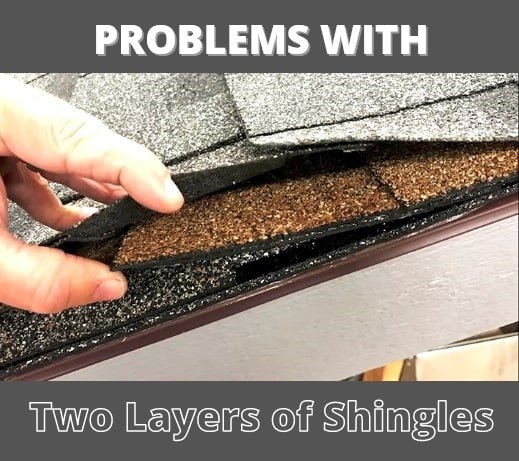Problems with two layers of roofing materials are real. Most homeowners may deny these facts because it’s too painful for them, but it’s important to be aware of the complications associated with layers of roofing shingles.
Not to mention that there is a repair code (which involves building codes) that doesn’t allow such a roof to be repaired. So, before you decide to have one, you probably need to consider some of these facts first.
Problems with Two Layers of Shingles
Adding a second layer of shingles—essentially placing new shingles on your roof over the old ones—is a tactic some might consider a good idea due to cost savings. Instead of a full replacement, you retain the existing shingles and add a new layer.

There are some different opinions about this two-layer model. Some building codes may allow it, but most of them don’t. In most cases, many building codes forbid such construction because it’s considered risky. Moreover, although this kind of roof may be beneficial for many homeowners, the downsides exceed the positive outcomes.
Read also: Average Roof Replacement Time
It’s cheaper and faster, allowing homeowners to save money. Stripping the roof is not only time-consuming but also expensive. With multiple shingles layers, the process is expedited, reducing costs significantly. But then again, be ready for some of these problems with two layers of shingles:
- You won’t be able to detect damages or leaks. You cannot check the sheathing because the old roof has been completely covered. You won’t know whether your roof suffers from leaks, rotted (or damaged) wood, algae growth, bad flashing, etc. Not only you won’t be able to see them, but you can’t fix them either.
- Your house’s safety is compromised due to the extra weight. Adding a second layer of shingles increases the load, stressing the roof system and potentially the roof decking. This is especially risky for snowfall and heavy rain.
- Your house can get hotter. Be logical. When there are several roof layers on top of your head, heat is trapped between those layers. This extra heat will also affect the shingles, creating premature aging.
Read also: Quick Fix for Roof Vent Leak During Heavy Rain
Can You Repair a Roof with Two Layers of Shingles?
In theory, repairs are possible, but practically, they are often not permitted. Building codes generally forbid repairs on two-layered roofs. Hence, replacement rather than repair might be your only option if damaged.
Most licensed contractors will avoid such jobs to comply with the law, and doing otherwise might lead to warranty issues with insurance companies.
The lifespan of the Second Layer of Shingles
In general and in theory, you can have around 20 years to 25 years of roof lifespan for the second layer. This is quite a long time. However, let’s not forget that it’s built on top of the existing roof. If the first roof is in bad shape, you can’t expect the second layer to hold up for those many years.
Conclusive Thoughts
The short-term effects may seem simple if you are thinking about having two layers of shingles. The procedure may seem inexpensive. But let’s not forget about the long-term effects and how it can harm your loved ones. Never underestimate the possible problems with two shingles layers and try your best to avoid them.


